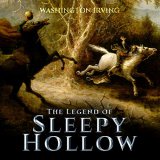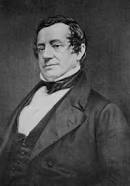The Legend of Sleepy Hollow Page #10
"The Legend of Sleepy Hollow" is a gothic story by American author Washington Irving, contained in his collection of 34 essays and short stories entitled The Sketch Book of Geoffrey Crayon, Gent.. Written while Irving was living abroad in Birmingham, England, "The Legend of Sleepy Hollow" was first published in 1820.
The brook was searched, but the body of the schoolmaster was not to be discovered. Hans Van Ripper as executor of his estate, examined the bundle which contained all his worldly effects. They consisted of two shirts and a half; two stocks for the neck; a pair or two of worsted stockings; an old pair of corduroy small-clothes; a rusty razor; a book of psalm tunes full of dog’s-ears; and a broken pitch-pipe. As to the books and furniture of the schoolhouse, they belonged to the community, excepting Cotton Mather’s “History of Witchcraft,” a “New England Almanac,” and a book of dreams and fortune-telling; in which last was a sheet of foolscap much scribbled and blotted in several fruitless attempts to make a copy of verses in honor of the heiress of Van Tassel. These magic books and the poetic scrawl were forthwith consigned to the flames by Hans Van Ripper; who, from that time forward, determined to send his children no more to school, observing that he never knew any good come of this same reading and writing. Whatever money the schoolmaster possessed, and he had received his quarter’s pay but a day or two before, he must have had about his person at the time of his disappearance. The mysterious event caused much speculation at the church on the following Sunday. Knots of gazers and gossips were collected in the churchyard, at the bridge, and at the spot where the hat and pumpkin had been found. The stories of Brouwer, of Bones, and a whole budget of others were called to mind; and when they had diligently considered them all, and compared them with the symptoms of the present case, they shook their heads, and came to the conclusion that Ichabod had been carried off by the Galloping Hessian. As he was a bachelor, and in nobody’s debt, nobody troubled his head any more about him; the school was removed to a different quarter of the hollow, and another pedagogue reigned in his stead. It is true, an old farmer, who had been down to New York on a visit several years after, and from whom this account of the ghostly adventure was received, brought home the intelligence that Ichabod Crane was still alive; that he had left the neighborhood partly through fear of the goblin and Hans Van Ripper, and partly in mortification at having been suddenly dismissed by the heiress; that he had changed his quarters to a distant part of the country; had kept school and studied law at the same time; had been admitted to the bar; turned politician; electioneered; written for the newspapers; and finally had been made a justice of the Ten Pound Court. Brom Bones, too, who, shortly after his rival’s disappearance conducted the blooming Katrina in triumph to the altar, was observed to look exceedingly knowing whenever the story of Ichabod was related, and always burst into a hearty laugh at the mention of the pumpkin; which led some to suspect that he knew more about the matter than he chose to tell. The old country wives, however, who are the best judges of these matters, maintain to this day that Ichabod was spirited away by supernatural means; and it is a favorite story often told about the neighborhood round the winter evening fire. The bridge became more than ever an object of superstitious awe; and that may be the reason why the road has been altered of late years, so as to approach the church by the border of the millpond. The schoolhouse being deserted soon fell to decay, and was reported to be haunted by the ghost of the unfortunate pedagogue and the plowboy, loitering homeward of a still summer evening, has often fancied his voice at a distance, chanting a melancholy psalm tune among the tranquil solitudes of Sleepy Hollow. POSTSCRIPT. FOUND IN THE HANDWRITING OF MR. KNICKERBOCKER. The preceding tale is given almost in the precise words in which I heard it related at a Corporation meeting at the ancient city of Manhattoes, at which were present many of its sagest and most illustrious burghers. The narrator was a pleasant, shabby, gentlemanly old fellow, in pepper-and-salt clothes, with a sadly humourous face, and one whom I strongly suspected of being poor--he made such efforts to be entertaining. When his story was concluded, there was much laughter and approbation, particularly from two or three deputy aldermen, who had been asleep the greater part of the time. There was, however, one tall, dry-looking old gentleman, with beetling eyebrows, who maintained a grave and rather severe face throughout, now and then folding his arms, inclining his head, and looking down upon the floor, as if turning a doubt over in his mind. He was one of your wary men, who never laugh but upon good grounds--when they have reason and law on their side. When the mirth of the rest of the company had subsided, and silence was restored, he leaned one arm on the elbow of his chair, and sticking the other akimbo, demanded, with a slight, but exceedingly sage motion of the head, and contraction of the brow, what was the moral of the story, and what it went to prove? The story-teller, who was just putting a glass of wine to his lips, as a refreshment after his toils, paused for a moment, looked at his inquirer with an air of infinite deference, and, lowering the glass slowly to the table, observed that the story was intended most logically to prove-- “That there is no situation in life but has its advantages and pleasures--provided we will but take a joke as we find it: “That, therefore, he that runs races with goblin troopers is likely to have rough riding of it. “Ergo, for a country schoolmaster to be refused the hand of a Dutch heiress is a certain step to high preferment in the state.” The cautious old gentleman knit his brows tenfold closer after this explanation, being sorely puzzled by the ratiocination of the syllogism, while, methought, the one in pepper-and-salt eyed him with something of a triumphant leer. At length he observed that all this was very well, but still he thought the story a little on the extravagant--there were one or two points on which he had his doubts. “Faith, sir,” replied the story-teller, “as to that matter, I don’t believe one-half of it myself.” D. K. THE END.
Translation
Translate and read this book in other languages:
Select another language:
- - Select -
- 简体中文 (Chinese - Simplified)
- 繁體中文 (Chinese - Traditional)
- Español (Spanish)
- Esperanto (Esperanto)
- 日本語 (Japanese)
- Português (Portuguese)
- Deutsch (German)
- العربية (Arabic)
- Français (French)
- Русский (Russian)
- ಕನ್ನಡ (Kannada)
- 한국어 (Korean)
- עברית (Hebrew)
- Gaeilge (Irish)
- Українська (Ukrainian)
- اردو (Urdu)
- Magyar (Hungarian)
- मानक हिन्दी (Hindi)
- Indonesia (Indonesian)
- Italiano (Italian)
- தமிழ் (Tamil)
- Türkçe (Turkish)
- తెలుగు (Telugu)
- ภาษาไทย (Thai)
- Tiếng Việt (Vietnamese)
- Čeština (Czech)
- Polski (Polish)
- Bahasa Indonesia (Indonesian)
- Românește (Romanian)
- Nederlands (Dutch)
- Ελληνικά (Greek)
- Latinum (Latin)
- Svenska (Swedish)
- Dansk (Danish)
- Suomi (Finnish)
- فارسی (Persian)
- ייִדיש (Yiddish)
- հայերեն (Armenian)
- Norsk (Norwegian)
- English (English)
Citation
Use the citation below to add this book to your bibliography:
Style:MLAChicagoAPA
"The Legend of Sleepy Hollow Books." Literature.com. STANDS4 LLC, 2024. Web. 23 Dec. 2024. <https://www.literature.com/book/the_legend_of_sleepy_hollow_261>.




Discuss this The Legend of Sleepy Hollow book with the community:
Report Comment
We're doing our best to make sure our content is useful, accurate and safe.
If by any chance you spot an inappropriate comment while navigating through our website please use this form to let us know, and we'll take care of it shortly.
Attachment
You need to be logged in to favorite.
Log In